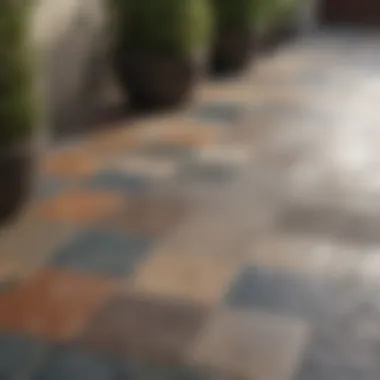Best Exterior Tiles: A Comprehensive Guide


Intro
Choosing the right exterior tile can significantly affect the aesthetics and functionality of outdoor spaces. This guide addresses various materials, designs, and practical concerns relevant to exterior tiling. Homeowners, designers, and gardening enthusiasts can benefit from a well-informed choice. With numerous options available, understanding the current trends and making informed decisions is essential.
Design Inspiration
Current Trends in Exterior Design
The world of exterior design is constantly evolving. Attention to sustainable materials, textures, and colors can enhance outdoor spaces. Homeowners tend to favor eco-friendly tiles made from recycled materials. Natural stone, ceramics, and porcelain offer versatility and durability. Each material has its unique characteristics, fitting various design styles.
Some recent trends include:
- Large format tiles: These create a seamless look, minimizing grout lines and providing a sophisticated finish.
- Textured surfaces: Tiles with textures can enhance grip, making spaces safer in wet conditions.
- Bold Colors and Patterns: Unique designs can serve as focal points in outdoor areas, making spaces feel lively yet elegant.
Color Schemes and Palette Ideas
Selecting the right colors is crucial for creating a desired atmosphere. Neutral tones like beige and gray are popular due to their versatility. However, vivid colors can inject personality into outdoor spaces. Pairing tiles with complementary plant life adds depth and visual interest.
Consider the following combinations:
- Warm Earth Tones: Browns and terracottas harmonize well with greenery.
- Cool Blues and Greens: These can complement water features or sandy outdoor areas.
- Classic Black and White: This timeless style adds elegance to patios and decks.
"Color is the keyboard, the eyes are the harmonies, the soul is the piano with many strings."
These palettes can greatly influence how outdoor spaces are perceived.
Practical Considerations
Choosing the Right Material
When choosing tiles, consider climate and usage. For instance, porcelain tiles are ideal for colder climates, as they are less porous and resist freezing. Natural stones add luxury but may require more maintenance. Understanding the purpose of the space aids in material selection.
Installation Processes
Proper installation is key to longevity. Hiring professionals ensures accuracy, especially when dealing with intricate patterns or heavy materials. Some essential steps in the process include:
- Site Preparation: Ensure the surface is level and clean.
- Laying Tiles: Start from the center and move outward for balanced aesthetics.
- Grouting and Sealing: This step is vital for preventing moisture infiltration.
Maintenance Requirements
Once installed, the upkeep of exterior tiles is essential to preserve their beauty and functionality. Regular cleaning and immediate repair of any damage will prolong their life. Depending on the material, sealing might be required to protect against stains and the environment.
End
Understanding Exterior Tiles
Understanding exterior tiles is crucial for both aesthetic and functional aspects of outdoor spaces. Tiles serve more than just a decorative purpose; they contribute to the durability and usability of your outdoor areas. This section highlights the significance of selecting the right tiles. Choosing the best exterior tiles can enhance the ambiance of your property while providing necessary protection against environmental elements.
When exploring exterior tiles, several key elements come into focus. First, materials play a fundamental role in the selection process. Each type of tile offers unique benefits and considerations, such as maintenance needs, installation methods, and sustainability.
Moreover, understanding exterior tiles helps homeowners, designers, and avid enthusiasts make informed choices that align with their aesthetic challenges, usage patterns, and budget constraints.
Definition and Purpose
Exterior tiles refer to the specialized tiles designed for outdoor use, suitable for a variety of applications such as patios, walkways, and pool surrounds. Their purpose extends beyond mere appearances; they are built to withstand various climatic conditions while providing slip resistance and durability. The primary function is to create functional outdoor spaces that are both safe and pleasing to the eye.
Materials Used in Exterior Tiles
- Porcelain: Porcelain tiles are often recognized for their exceptional durability and low porosity. This material is made from finely ground clay and fired at high temperatures, which results in a denser and less water-absorbent surface. The key characteristic of porcelain is its durability, making it an excellent choice for high-traffic areas. Additionally, it can mimic natural stone or wood, providing versatility in design. However, its installation may require more expertise, often leading to higher installation costs.
- Natural Stone: Natural stone tiles, which include materials like granite, slate, and travertine, showcase a unique aesthetic appeal that is hard to replicate. These tiles are favored for their organic beauty and durability. The key characteristic is that each piece is distinct, offering a one-of-a-kind look. They resist fading and are generally strong, making them suitable for outdoor applications. However, natural stone can be costly and may require regular sealing to maintain its appearance in harsh weather conditions.
- Ceramic: Ceramic tiles are another widely used option. They are typically less expensive than natural stone or porcelain and come in a wide variety of designs. The versatility of ceramic allows for creative patterns and colors to suit different styles. The water resistance of ceramic tiles makes them appropriate for areas around pools. Although they are affordable, they may not perform as well under extreme weather or heavy loads compared to porcelain or natural stone.
- Composite Materials: Composite tiles are gaining traction due to their blend of synthetic materials that offer benefits like durability and low maintenance. They often replicate the look of natural materials without the associated downsides. The key characteristic is their sustainability, often being made from recycled materials. Composite tiles are resistant to moisture and fading, making them ideal for outdoor spaces. Their drawback can be a perception of lower quality compared to traditional materials, yet they offer robust performance overall.


Types of Exterior Tiles
The topic of Types of Exterior Tiles is essential in this article. It provides a vital framework for understanding the variety of materials available for outdoor spaces. Each type of tile offers specific qualities, benefits, and considerations. Understanding these elements helps homeowners and designers to make informed decisions regarding both aesthetics and functionality.
Porcelain Tiles
Characteristics
Porcelain tiles are known for their dense structure and low water absorption rate. This makes them a preferred option in many outdoor settings. Their durability distinguishes them as a solid choice for facing extreme weather conditions. They offer a range of colors and styles, appealing to various preferences. Their ability to resist staining and scratching enhances their value in outdoor applications.
Advantages
The main advantage of porcelain tiles is their resilience. They do not fade easily under sunlight and offer excellent frost resistance. This longevity contributes to their popularity among homeowners looking for low-maintenance options. Their easy-to-clean surface is a major benefit, especially for high-traffic areas. However, the installation process can be complicated due to their weight.
Applications
Porcelain tiles are suitable for a variety of outdoor applications. They can be effectively used for patios, walkways, and pool areas. Their design versatility allows them to fit into modern as well as traditional settings. However, they must be installed properly to take advantage of their full potential. Missteps during installation can result in cracking.
Natural Stone Tiles
Types of Natural Stone
Natural stone tiles include granite, slate, limestone, and travertine. Each type possesses unique characteristics and aesthetic appeal. For example, granite is known for its strength and beauty, while travertine offers a more rustic charm. The variety available allows for personalized design choices. However, the cost can vary significantly based on the type selected.
Installation Considerations
When it comes to installing natural stone tiles, there are several important factors to consider. The weight of natural stone requires a solid and stable substrate. Ensuring proper sealing is crucial to prevent water damage and staining. The installation can also take a longer time compared to other materials, which may pose challenges for some homeowners.
Maintenance Tips
Maintaining natural stone requires consistent effort to protect its appearance. Regular sealing is essential to guard against moisture and spills. Gentle cleaning agents are recommended to avoid damaging the stone’s surface. Over time, natural stone can develop a unique patina, but this requires proper care to maintain its beauty.
Ceramic Tiles
Design Versatility
Ceramic tiles provide exceptional design versatility. They come in an extensive range of colors and patterns, making them suitable for various design concepts. This adaptability allows them to blend seamlessly into outdoor or garden spaces. While they are typically seen in residential areas, their use in commercial applications is growing as well.
Water Resistance
Ceramic tiles exhibit moderate water resistance, suitable for outdoor use in areas with mild climates. Their smooth surface helps in resisting water infiltration. Nevertheless, extreme conditions can impact their longevity. It is vital to choose high-quality ceramic tiles specifically intended for exterior use to ensure durability.
Installation Methods
There are multiple methods for installing ceramic tiles, including thin-set and mud-set techniques. Thin-set is commonly used due to its ease and effectiveness. Proper spacing is crucial during installation to accommodate natural expansion and contraction during seasonal changes. In contrast, mud-set requires more preparation but provides additional stability.
Composite Tiles
Materials Used
Composite tiles incorporate a mixture of materials, including wood fibers and recycled plastics. This combination makes them durable and environmentally friendly. Their production process contributes to waste reduction, appealing to eco-conscious consumers. However, the quality can vary, making it imperative for buyers to understand each product's specifications.
Sustainability Aspects
The sustainability aspect of composite tiles plays a significant role in their appeal. Many options are made from recycled materials, reducing their environmental footprint. This potential for reuse and recycling supports broader ecological goals. Nonetheless, buyers should verify the sourcing and manufacturing processes to ensure actual sustainability benefits.
Cost-Effectiveness
Composite tiles often provide an attractive cost-effective solution. Their durability means less frequent replacements, which saves money in the long run. Additionally, the lower maintenance needs contribute to overall savings. However, initial costs might be higher than traditional materials, which necessitates thorough budgeting before proceeding with a project.


Selecting the Right Tile for Your Space
Choosing the right tile for outdoor areas is crucial. This decision influences both aesthetics and functionality. An appropriate tile will enhance the visual appeal of your space while ensuring durability against the elements. To make informed choices, homeowners must consider several factors, including environmental conditions and design compatibility.
Environmental Considerations
Climate Effects on Tile Performance
Climate plays a significant role in how tiles perform outdoors. For instance, areas with heavy rainfall require materials that resist water absorption. Porcelain tiles, known for their low porosity, are often recommended for such environments. They withstand freezing temperatures without cracking, making them a go-to option in colder regions.
In contrast, natural stone may absorb water and could be prone to damage in similar conditions. Homeowners must assess their local weather patterns to select tiles that will last and retain their appearance over time.
Eco-Friendly Options
The demand for eco-friendly materials is rising. Choosing tiles made from recycled or sustainably sourced materials addresses environmental concerns. Options like composite tiles may incorporate recycled content, reducing environmental impact. These tiles are not only better for the planet but often come with lower maintenance requirements, offering a practical advantage.
Investing in eco-friendly options also enhances a property's market appeal. More buyers are looking for sustainable features, making these tiles a smart choice for the environmentally conscious homeowner.
Design and Aesthetics
Color Palettes
Color plays an essential role in the selection of exterior tiles. The right color can harmonize with landscaping and architectural styles. A neutral palette may appeal to those seeking timeless elegance, while vibrant hues can add character to outdoor spaces.
Homeowners should also consider how colors may appear in different lighting conditions. For example, bright tiles may look different under direct sunlight compared to shaded areas. Thus, testing samples outdoors before making a final decision is wise.
Style Compatibility
Style compatibility is paramount in achieving a cohesive look. Whether modern, rustic, or traditional, tiles should align with the overall theme of the property. For instance, sleek porcelain tiles work well in contemporary designs, while natural stone complements rustic aesthetics.
Each style has its unique attributes, influencing the choice of finishing materials as well. Depending on the desired atmosphere, proper alignment with the architecture is vital for a polished appearance.
Safety and Durability
Slip-Resistance Ratings
Safety is a primary concern for outdoor spaces. Slip-resistant tiles minimize the risk of accidents, particularly when wet. Tiles are rated on a slip-resistance scale, guiding choices based on the intended area of use.
For pool decks or patios, it is crucial to select tiles with higher slip-resistance ratings. This consideration enhances safety while maintaining aesthetic value, making them important for family-friendly environments.
Long-term Performance
Durability reflects long-term performance in exterior tiles. Choosing the right materials ensures that the investment lasts despite exposure to weather, foot traffic, and other stressors. Some tiles require more upkeep than others, impacting their longevity.
Porcelain tiles are highly regarded for their resilience, resisting scratches and stains effectively. Natural stone, while beautiful, may necessitate more maintenance to preserve its integrity. Therefore, understanding the trade-offs between beauty and practicality will guide homeowners in their selection process.
Installation Process
The installation process of exterior tiles is crucial in ensuring the effectiveness and longevity of any outdoor space. A proper installation not only enhances the aesthetics but also improves functionality and durability against environmental elements. Without a well-thought-out installation strategy, even the finest tiles can suffer damage and create a visually unappealing environment.
Preparation Steps
Before installing exterior tiles, preparation is essential. The surface where the tiles will be laid must be adequately prepared to avoid future complications. This involves cleaning the area, removing any debris, and ensuring the surface is level. Any unevenness can lead to uneven tile placement and potential future damage, such as cracking or shifting. It is important to check for drainage as well, ensuring that water will flow away from the tiles rather than pooling on or beneath them.
Installation Techniques
Dry-Laying
Dry-laying refers to the method of placing tiles without adhesive to evaluate how they will fit in the designated space. This technique allows homeowners or installers to visualize the pattern and adjust tiles before committing to the installation. One key characteristic of dry-laying is its ability to help plan the layout efficiently, which can save time and reduce waste during the actual installation phase. A benefit of this method is that it helps to prevent errors because adjustments can be made easily when the tiles are not yet fixed in place. However, a disadvantage is that it can be time-consuming, particularly for larger areas.


Mortar Bed Installation
Mortar bed installation involves the application of a thick layer of mortar to create a stable and level surface for tile placement. This technique is popular for its durability and ability to withstand heavy foot traffic. A prominent feature of mortar bed installations is that they create a solid foundation, suitable for various types of exterior tiles. One advantage of this method is that it allows for meticulous leveling, ensuring a flat surface. However, it requires skill and experience, as improper mixing or application could lead to issues such as cracking or bonding failure.
Post-Installation Care
After the tiles are installed, post-installation care plays an integral role in maintaining their appearance and longevity. Proper care helps to protect the investment made in exterior tiling.
Grouting Techniques
Grouting fills the spaces between tiles and provides added support. It is a critical aspect of the installation as it prevents moisture infiltration and improves overall stability. A notable characteristic of grouting techniques is their ability to enhance the visual appeal of the tiled area by providing a finished look. Using high-quality grout can be a beneficial choice, as it offers better resistance to stains and cracking. However, if not applied correctly, it may lead to issues like uneven surfaces or mold growth if moisture gets trapped underneath.
Sealant Application
Sealant application is crucial in extending the life of the tiles and preventing stains, moisture infiltration, or damage from environmental factors. Properly applied sealant can help in maintaining the integrity of the tiles and enhancing their appearance. A significant advantage of using sealants is that they provide a protective layer, minimizing maintenance needs over time. However, choosing the wrong type of sealant or improper application may lead to reduced effectiveness or even damage to the tiles.
It is essential to follow the manufacturer's recommendations for both grouting and sealing to achieve the best results.
In summary, understanding each step in the installation process contributes significantly to achieving a successful outcome for exterior tile projects. From proper preparation to the techniques used in installation and post-care practices, every element will affect the performance and appearance of exterior tiles.
Maintenance and Troubleshooting
Maintenance and troubleshooting are pivotal aspects to consider when it comes to exterior tiles. These factors can significantly impact both the longevity and appearance of your outdoor surfaces. Regular maintenance ensures that tiles remain visually appealing while preserving their functionality. Ignoring maintenance can lead to costly repairs and a diminished aesthetic value, making it essential for homeowners and designers to understand these elements thoroughly.
Regular Maintenance Practices
Cleaning Recommendations
Cleaning recommendations for exterior tiles are fundamental to their upkeep. A consistent cleaning routine prevents dirt, grime, and mildew from accumulating. This not only enhances the visual appeal but also prolongs the tile's lifespan. The use of mild detergents combined with warm water is generally effective. A soft-bristle brush can be utilized to avoid scratching the tile surface.
Key characteristics of effective cleaning recommendations include simplicity and efficiency. They are popular choices because they require minimal effort while yielding substantial results. Regular cleaning keeps tiles looking fresh and maintained. However, it's important to be cautious with aggressive cleaning agents, as they can cause discoloration or damage.
Preventive Measures
Preventive measures play a crucial role in maintaining the integrity of exterior tiles. These measures entail actions like applying sealants, using non-slip treatments, and conducting routine inspections. Sealants help prevent water intrusion which can lead to cracks and chips. Using non-slip solutions enhances safety, especially in wet conditions.
The key characteristic of preventive measures is their proactive nature. They support long-term durability while reducing the risk of major issues. These measures are favorable as they encourage a less reactive approach to tile care. One disadvantage, however, is that initial costs for high-quality sealants might be higher, but the long-term benefits often justify this investment.
Common Issues and Solutions
Cracking and Chipping
Cracking and chipping are common problems encountered with exterior tiles. These issues often occur due to extreme weather conditions or heavy foot traffic. Regular monitoring of tiles can help identify any signs of damage early. Addressing these issues promptly can prevent further degradation and costly repairs.
A key characteristic of cracking and chipping is their aesthetic impact. They can detract significantly from the overall appearance of outdoor spaces. This makes prompt attention to these problems a beneficial choice for maintaining property value. A unique feature of these issues is their potential for easy repair using specialized grout or fillers. However, severe damage may require replacing the entire tile, which could be challenging.
Discoloration
Discoloration is another frequent concern that can impact exterior tiles. This may result from exposure to harsh sunlight, moisture, or substances like oil and chemicals. Regular cleaning can help mitigate this, but sometimes discoloration can prove persistent.
The key characteristic of discoloration is its direct effect on visual appeal. It can create an unkempt appearance that detracts from outdoor aesthetics. Managing discoloration becomes critical, especially for homeowners aiming to maintain a pristine look. A distinct feature of this issue is that some discoloration may respond well to thorough cleaning, while others may require professional treatments. Discoloration can be a tricky problem to navigate, especially if it involves color fading that doesn’t restore with regular cleaning. This emphasizes the importance of preventive measures in maintaining tile appearance.
End and Future Trends
The topic of exterior tiles plays a significant role in the overall aesthetic and functional qualities of outdoor spaces. Understanding the latest trends and concluding insights allows both homeowners and designers to make educated decisions regarding their outdoor tiling needs. This section aims to distill the insights gathered from previous sections while also looking into the future of tile design.
Summary of Key Points
In reviewing what has been discussed, several key points stand out:
- Material Variety: Exterior tiles come in multiple materials, including porcelain, natural stone, ceramic, and composite materials. Each material offers its own unique features suited to different applications.
- Tile Selection Considerations: It is crucial to account for environmental factors, design intentions, and safety in selecting the right tiles. A suitable tile can enhance the functionality of an outdoor area.
- Installation and Maintenance: A proper installation process alongside regular maintenance is essential to ensure tiles remain in optimal condition over time.
- Common Issues: Understanding potential problems such as cracking, chipping, or discoloration allows homeowners to take preventive action.
Emerging Innovations in Tile Design
Innovations in tile design are ongoing. This enhances both functionality and aesthetics, making exterior tiles more appealing to a wider audience. Some of the notable trends include:
- Smart Tiles: Technology integration such as sensors in tiles that can monitor environmental conditions is emerging. These smart tiles can increase safety and even contribute to energy efficiency.
- Sustainability: With increasing awareness regarding environmental impact, manufacturers are producing eco-friendly tiles made from recycled materials. This shift promotes green living.
- Custom Designs: Advances in printing technologies allow for customizable tile designs that enable homeowners to personalize their spaces further.
- Textured Finishes: Non-slip textures are becoming standard, increasing safety in outdoor environments without sacrificing aesthetics.



